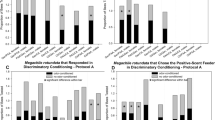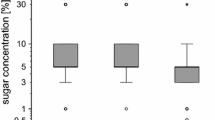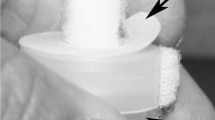Abstract
Learning olfactory stimuli and their implications is essential in bumblebees for orientation and recognition of nest sites and food sources. To evaluate associative learning abilities in bees under controlled environmental conditions, the proboscis extension response (PER) assay is a well-established method used in honeybees and has recently been successfully adapted to bumblebees. In this study, we examined the cognitive abilities of workers of the eusocial bumblebee, Bombus terrestris, by training individuals in different olfactory learning tasks using classical PER conditioning. We compared learning performance for four different floral odors. Individuals were able to solve absolute (A+) and differential (A+ vs. B−) conditioning tasks, and no differences were found between single odors and odor combinations, respectively. Furthermore, bumblebees performed well on a positive pattern discrimination task (A−, B− vs. AB+), but failed to solve the negative pattern discrimination (A+, B+ vs. AB−). Our results indicate that workers of B. terrestris possess elemental olfactory learning abilities, but, in contrast to previous findings in honeybees, fail in more complex tasks, such as negative pattern discrimination. We discuss possible ultimate causes that have led to the difference in learning capabilities between bumblebees and honeybees.




Similar content being viewed by others
References
Anfora, G., Rigosi, E., Frasnelli, E., Ruga, V., Trona, F., Vallortigara, G. (2011) Lateralization in the invertebrate brain: left-right asymmetry of olfaction in bumble bee, Bombus terrestris. PLoS One 6(4), e18903
Bhagavan, S., Smith, B.H. (1997) Olfactory conditioning in the honeybee, Apis mellifera: effects of odor intensity. Physiol. Behav. 61(1), 107–117
Bitterman, M.E., Menzel, R., Fietz, A., Schäfer, S. (1983) Classical conditioning of proboscis extension in honeybees (Apis mellifera). J. Comp. Psychol. 97(2), 107–119
Brill, M.F., Rosenbaum, T., Reus, I., Kleineidam, C.J., Nawrot, M.P., Rössler, W. (2013) Parallel processing via a dual olfactory pathway in the honeybee. J. Neurosci. 33(6), 2443–2456
Couvillon, P.A., Bitterman, M.E. (1988) Compound-component and conditional discrimination of colors and odors by honeybees: Further tests of a continuity model. Anim. Learn. Behav. 16(1), 67–74
Dacher, M., Smith, B.H. (2008) Olfactory interference during inhibitory backward pairing in honeybees. PLoS One 3(10), e3513
Deisig, N., Lachnit, H., Giurfa, M. (2001) Configural olfactory learning in honeybees: negative and positive patterning discrimination. Learn. Mem. 8, 70–78
Deisig, N., Lachnit, H., Giurfa, M. (2002) The effect of similarity between elemental stimuli and compounds in olfactory patterning discriminations. Learn. Mem. 9(3), 112–121
Deisig, N., Lachnit, H., Sandoz, J.C., Lober, K., Giurfa, M. (2003) A modified version of the unique cue theory accounts for olfactory compound processing in honeybees. Learn. Mem. 10(3), 199–208
Dukas, R. (2008) Evolutionary biology of insect learning. Annu. Rev. Entomol. 53, 145–160
Fauria, K., Dale, K., Colborn, M., Collett, T. (2002) Learning speed and contextual isolation in bumblebees. J. Exp. Biol. 205, 1009–1018
Free, J.B. (1970) The flower constancy of bumblebees. J. Anim. Ecol. 39(2), 395–402
Giurfa, M. (2003) Cognitive neuroethology: dissecting non-elemental learning in a honeybee brain. Curr. Opin. Neurobiol. 13(6), 726–735
Giurfa, M. (2007) Behavioral and neural analysis of associative learning in the honeybee: a taste from the magic well. J. Comp. Physiol. A .Neuroethol. Sens. Neural. Behav. Physiol. 193(8), 801–824
Giurfa, M., Sandoz, J.C. (2012) Invertebrate learning and memory: fifty years of olfactory conditioning of the proboscis extension response in honeybees. Learn. Mem. 19(2), 54–66
Grant, V. (1950) The flower constancy of bees. Bot. Rev. 16(7), 379–398
Gumbert, A. (2000) Color choices by bumble bees (Bombus terrestris): innate preferences and generalization after learning. Behav. Ecol. Sociobiol. 48, 36–43
Hussaini, S.A., Komischke, B., Menzel, R., Lachnit, H. (2007) Forward and backward second-order Pavlovian conditioning in honeybees. Learn. Mem. 14(10), 678–683
Jakobsen, H.B., Kristjánsson, K., Rohde, B., Terkildsen, M., Olsen, C.E. (1995) Can social bees be influenced to choose a specific feeding station by adding the scent of the station to the hive air? J. Chem. Ecol. 21(11), 1635–1648
Kapustjanskij, A., Streinzer, M., Paulus, H.F., Spaethe, J. (2007) Bigger is better: implications of body size for flight ability under different light conditions and the evolution of alloethism in bumblebees. Funct. Ecol. 21(6), 1130–1136
Knudsen, J.T., Tollsten, L., Bergström, L.G. (1993) Floral Scents—a checklist of volatile compounds isolated by head-space techniques. Phytochemistry 33(2), 253–280
Komischke, B., Sandoz, J.-C., Lachnit, H., Giurfa, M. (2003) Non-elemental processing in olfactory discrimination tasks needs bilateral input in honeybees. Behav. Brain Res. 145(1–2), 135–143
Kuwabara, M. (1957) Bildung des bedingten Reflexes von Pavlovs Typus bei der Honigbiene Apis mellifera. J. Fac. Scie. Hokkaido Univ. Ser. VI Zool. 13, 458–464
Laloi, D., Bailez, O., Blight, M.M., Roger, B., Pham-Delègue, M.H., Wadhams, L.J. (2000) Recognition of complex odors by restrained and free-flying honeybees, Apis mellifera. J. Chem. Ecol. 26(10), 2307–2319
Laloi, D., Pham-Delègue, M.H. (2004) Bumblebees show asymmetrical discrimination between two odors in a classical conditioning procedure. J. Insect Behav. 17(3), 385–396
Laloi, D., Sandoz, J.C., Picard-Nizou, A.L., Marchesi, A., Pouvreau, A., Taséi, J.N., Poppy, G., Pham-Delègue, M.H. (1999) Olfactory conditioning of the proboscis extension in bumble bees. Entomol. Exper. Appl. 90, 123–129
Matsumoto, Y., Menzel, R., Sandoz, J.C., Giurfa, M. (2012) Revisiting olfactory classical conditioning of the proboscis extension response in honey bees: a step toward standardized procedures. J. Neurosci. Methods 211(1), 159–167
Mc Cabe, S.I., Farina, W.M. (2010) Olfactory learning in the stingless bee Tetragonisca angustula (Hymenoptera, Apidae, Meliponini). J. Comp. Physiol. A Neuroethol. Sens. Neural. Behav. Physiol. 196(7), 481–490
Menzel, R., Giurfa, M., Gerber, B., Hellstern, F. (1999) Elementary and configural forms of memory in an insect: the honeybee. In: Friederici, A.D., Menzel, R. (eds.) Learning: Rule Extraction and Representation, pp. 259–282. Walter de Gruyter, Berlin, New York
Menzel, R., Müller, U. (1996) Learning and memory in honeybees: from behavior to neural substrates. Annu. Rev. Neurosci. 19, 379–404
Morawetz, L., Spaethe, J. (2012) Visual attention in a complex search task differs between honeybees and bumblebees. J. Exp. Biol. 215(Pt 14), 2515–2523
Pearce, J.M. (1987) A Model for stimulus generalization in Pavlovian conditioning. Psychol. Rev. 94(1), 61–73
Pearce, J.M., Bouton, M.E. (2001) Theories of associative learning in animals. Annu. Rev. Psychol. 52, 111–139
Pelz, C., Gerber, B., Menzel, R. (1996) Odorant intensity as a determinant for olfactory conditioning in honeybees: roles in discrimination, over-shadowing, and memory consolidation. J. Exp. Biol. 200, 837–847
Raine, N.E., Chittka, L. (2007). Flower Constancy and memory dynamics in bumblebees (Hymenoptera: Apidae: Bombus). Entomol. Gen. 29(2–4), 179–199
Raine, N.E., Chittka, L. (2008) The correlation of learning speed and natural foraging success in bumblebees. Proc. Biol. Sci. 275(1636), 803–808
Reinhard, J., Sinclair, M., Srinivasan, M.V., Claudianos, C. (2010) Honeybees learn odor mixtures via a selection of key odorants. PLoS One 5(2), e9110
Rescorla, R.A. (1972) "Configural" conditioning in discrete-trial bar pressing. J. Comp. Physiol. Psychol. 79(2), 307–317
Rescorla, R.A., Wagner, A.R. (1972) A theory of Pavlovian conditioning: variations in the effectiveness of reinforcement and non-reinforcement. In: Black, A.H., Prokasy, W.F. (eds.) Classical Conditioning 2: Current research and theory, pp. 64–99. Appleton, New York
Riveros, A.J., Gronenberg, W. (2009a) Learning from learning and memory in bumblebees. Commun. Integr. Biol. 2(5), 437–440
Riveros, A.J., Gronenberg, W. (2009b) Olfactory learning and memory in the bumblebee Bombus occidentalis. Naturwissenschaften 96(7), 851–856
Rudy, J.W., Sutherland, R.J. (1992) Configural and elemental associations and the memory coherence problem. J. Cogn. Neurosci. 4(3), 208–216
Sandoz, J.C., Pham-Delègue, M.H., Renou, M., Wadhams, L.J. (2001) Asymmetrical generalization between pheromonal and floral odors in appetitive olfactory conditioning of the honeybee (Apis mellifera L.). J. Comp. Physiol. A 187, 559–568
Spaethe, J., Brockmann, A., Halbig, C., Tautz, J. (2007) Size determines antennal sensitivity and behavioral threshold to odors in bumblebee workers. Naturwissenschaften 94(9), 733–739
Spaethe, J., Chittka, L. (2003) Interindividual variation of eye optics and single object resolution in bumblebees. J. Exper. Biol. 206(19), 3447–3453
Toda, N.R., Song, J., Nieh, J.C. (2009) Bumblebees exhibit the memory spacing effect. Naturwissenschaften 96(10), 1185–1191
Wagner, A.R., Rescorla, R.A. (1972) Inhibition in Pavlovian conditioning: application of a theory. In: Halliday, M.S., Boakes, R.A. (eds.) Inhibition and learning, pp. 301–336. Academic, London
Worden, B.D., Skemp, A.K., Papaj, D.R. (2005) Learning in two contexts: the effects of interference and body size in bumblebees. J. Exp. Biol. 208(Pt 11), 2045–2053
Wright, G.A., Carlton, M., Smith, B.H. (2009) A honeybee's ability to learn, recognize, and discriminate odors depends upon odor sampling time and concentration. Behav. Neurosci. 123(1), 36–43
Acknowledgments
We would like to thank Karin Möller for rearing the bumblebees. We also thank two anonymous reviewers for their helpful comments on an earlier draft of this manuscript. This work was supported by a PhD research scholarship offered by the Free State of Bavaria (Elitenetzwerk Bayern) to FMJS.
Author information
Authors and Affiliations
Corresponding author
Additional information
Manuscript editor: Bernd Grünewald
Apprentissage olfactif de base ou complexe par conditionnement du REP (réflexe d’extension du proboscis) chez le bourdon, Bombus terrestris
Apprentissage élémentaire / bourdon / REP / associations configurales
Elementares und nicht-elementares olfaktorisches Lernen bei der PER-Konditionierung der Hummel Bombus terrestris
Elementares Lernen / Bombus terrestris / Rüsselreflexkonditionierung / Hummel / konfigurale Assoziationen
Electronic supplementary material
Below is the link to the electronic supplementary material.
ESM 1
(PDF 178 kb)
Rights and permissions
About this article
Cite this article
Sommerlandt, F.M.J., Rössler, W. & Spaethe, J. Elemental and non-elemental olfactory learning using PER conditioning in the bumblebee, Bombus terrestris . Apidologie 45, 106–115 (2014). https://doi.org/10.1007/s13592-013-0227-4
Received:
Revised:
Accepted:
Published:
Issue Date:
DOI: https://doi.org/10.1007/s13592-013-0227-4
Keywords
Profiles
- Wolfgang Rössler View author profile




